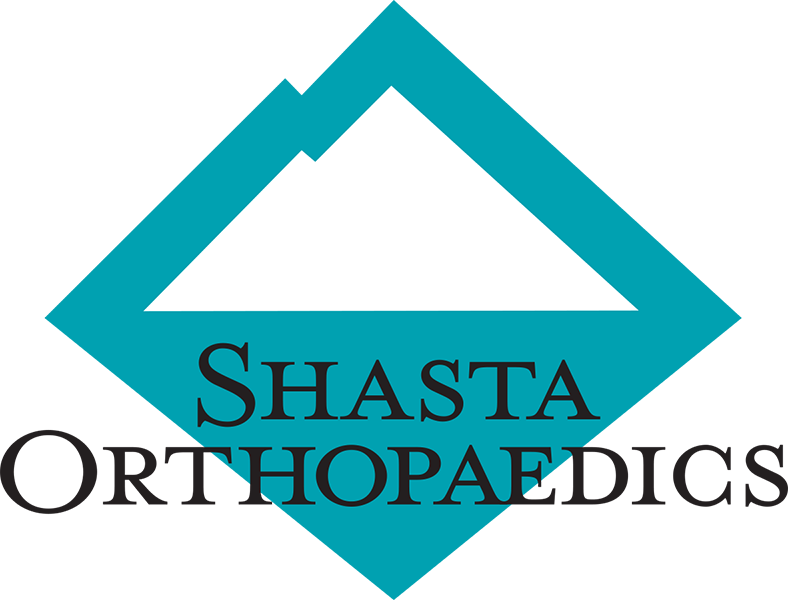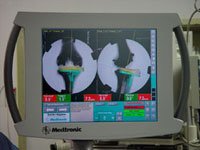 The First Fluoro Computer-Assisted Knee Replacement Surgery in North America Using Smith & Nephew Technology Performed in Redding, CA on April 10, 2002
The First Fluoro Computer-Assisted Knee Replacement Surgery in North America Using Smith & Nephew Technology Performed in Redding, CA on April 10, 2002
On April 10th, 3 surgeons; Brian Edkin, MD, John Lange, MD, and Paul Schwartz, MD of Shasta Orthopaedics & Sports Medicine, successfully performed the first 3 knee replacements in North America using new computer-assisted technology at Mercy Medical Center in Redding.
The software operates highly accurate cameras to track the movement of bones and instrumentation during surgery; a clinical advancement to assist the surgeon’s goal of more accurate alignment of the knee joint in patients who undergo knee replacement operations.
Benefits
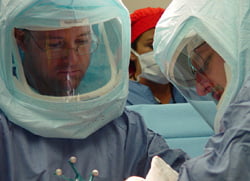 The image-guided total knee surgical technique results in a number of benefits for the patient. For instance, the new procedure eliminates the use of an intramedullary rod, thereby reducing the chance of fat embolism.
The image-guided total knee surgical technique results in a number of benefits for the patient. For instance, the new procedure eliminates the use of an intramedullary rod, thereby reducing the chance of fat embolism.
Additionally, the onscreen mapping of anatomical landmarks around the knee permits very accurate measurements and cuts, potentially reducing implant failure due to misalignment or ligament imbalance. In fact, surgeons are able to superimpose a real time image of a Smith & Nephew knee implant over the proposed cuts on screen, allowing them to see the fit of the implant and the results of the proposed bone preparation before the first cut is made.
Smith & Nephew’s knee software, which utilizes Medtronic’s IntraOperative Navigation (ION) System, is the first to provide the quantitative measurement of joint laxity during surgery. Traditionally, surgeons assess the flexibility of the knee’s ligaments by hand, and roughly estimate how much correction should be made to each ligament to achieve joint balance. Now, surgeons are able to more accurately measure joint laxity on screen.Future applications will allow this information to be used to make intraoperative decisions regarding soft tissue balancing ú a critical factor in knee replacement success.
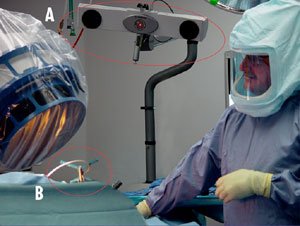
John Lange, MD, during one of the first surgeries on April 10, 2002. The equipment in the background (A) receives data from the sensor at lower left (B)which is attached to the patient’s leg.
The Food and Drug Administration (FDA) has given market clearance to this specially-designed computer-assisted instruments and software designed for use in the next generation of total knee replacement surgery. This new image-guided procedure uses a software application specific to Smith & Nephew Orthopaedics’ total knee systems. It is the orthopaedic industry’s first computer-assisted software using fluoroscopic imaging for total knee replacement to receive FDA clearance and signals Smith & Nephew’s commitment to using technology as an enabler to bring less invasive and more accurate knee, hip and trauma applications to orthopaedic surgeons and patients.
“FDA clearance for our software and instruments will enable surgeons to perform total knee surgery more accurately, which may result in better long-term results, less patient morbidity and quicker recovery,” said Scott Elliott, Smith & Nephew’s vice president of computer-assisted surgery. “We’re dedicated to providing image-guided tools that will improve orthopaedic outcomes. Combining our knee implants and instruments with intuitive software will help set a new standard of care in orthopaedic surgery. This is just the beginning of our innovation in this field.” “We achieved dramatic results with our inaugural procedures,” said Elliott. “The first two of these initial surgeries involved complex joint deformities, and both outcomes were successful and highly accurate.”
Computer Assisted Surgery, April 2002
What are the primary benefits of this procedure?
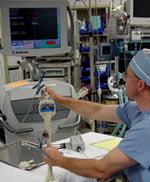
It’s significantly less invasive than traditional total knee replacement surgery, especially since it eliminates the need for an IM rod to be inserted down the length of the femur. Also, it is very accurate, and many surgeons believe that this accuracy will reduce early implant failure due to misalignment during surgery.
Right now, only a handful of surgeons, including those at Shasta Othopaedics & Sports Medicine, are trained in and performing the procedure, although Smith & Nephew is working to expand its availability nationwide.
Does anybody else besides Smith & Nephew provide this comprehensive a package?
No other single company offers the implant, the instrumentation and the application-specific software for total knee arthroplasty (TKA). This is the first fluoroscopic based image-guided total knee system to be cleared.
Can doctors use knee systems manufactured by other companies?
Right now, the software is designed for Smith & Nephew knee implants only.
What is the nature of Smith & Nephew’s relationship with Medtronic?
Medtronic SNT provides the hardware (the iON Fluoronav system), and Smith & Nephew has worked closely with them to develop the total knee software application for it. It is their system’s first non-spine orthopaedic procedure.
This is the first fluoroscopic TKA procedure to receive clearance. What does that mean and why is it good?
 We think it is an important first step in our strategy to move out ahead of the competition with this technology. Other image-guided systems use CT-scans or imageless technologies. Fluoroscopy is superior to either of these due to its low cost, accuracy, and interoperative simplicity. CT-based systems require an expensive CT-scan prior to surgery and many surgeons feel imageless systems are less accurate than desired.
We think it is an important first step in our strategy to move out ahead of the competition with this technology. Other image-guided systems use CT-scans or imageless technologies. Fluoroscopy is superior to either of these due to its low cost, accuracy, and interoperative simplicity. CT-based systems require an expensive CT-scan prior to surgery and many surgeons feel imageless systems are less accurate than desired.
How many surgeons do you think will change their procedure as a result of this, and how quickly do you expect it to happen?
Smith & Nephew estimates that 25-30% of all orthopaedic surgery will be done with image-guided technology in the next 5-7 years.
Why is CAS worth pursuing?
When it reaches maturity, CAS will support the fundamental objectives of virtually every orthopaedic surgeon:
- Minimally invasive surgical procedures result in easier rehabilitation/less morbidity.
- The learning curve for orthopaedic surgical skills is dramatically reduced.
- Presently, many implant failures are due to misalignment during surgery.
Surgeons believe that CAS will dramatically improve accuracy of bone cuts and implant placement, thus improving the long-term results of Smith & Nephew products.
- Faster surgery results in less morbidity and reduces the chance for infection.
- Different instrument and implant concepts facilitate these new approaches
